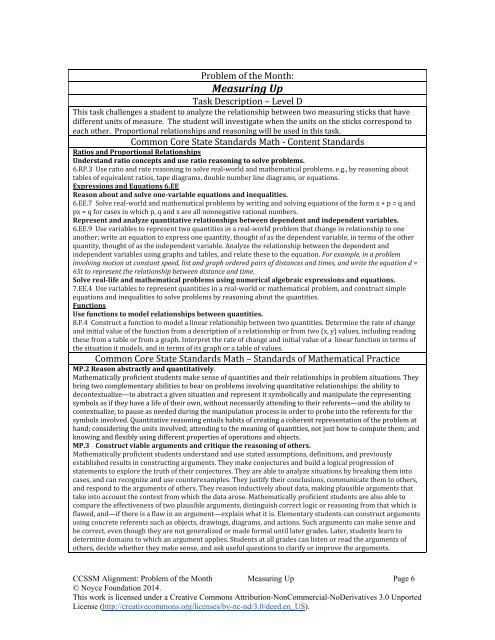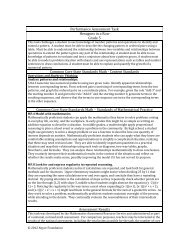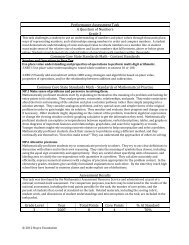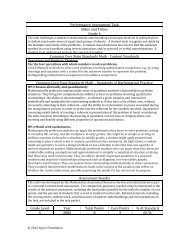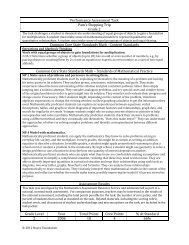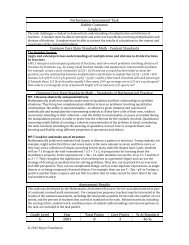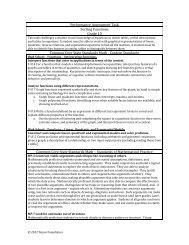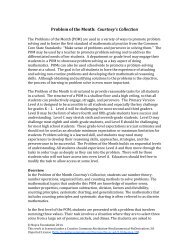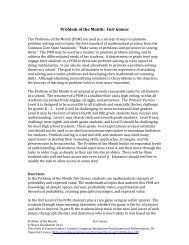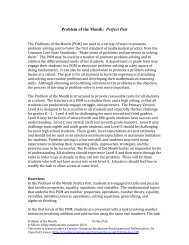Problem of the Month Measuring Up
Problem of the Month: Measuring Up - Inside Mathematics
Problem of the Month: Measuring Up - Inside Mathematics
You also want an ePaper? Increase the reach of your titles
YUMPU automatically turns print PDFs into web optimized ePapers that Google loves.
<strong>Problem</strong> <strong>of</strong> <strong>the</strong> <strong>Month</strong>:<br />
<strong>Measuring</strong> <strong>Up</strong><br />
Task Description – Level D<br />
This task challenges a student to analyze <strong>the</strong> relationship between two measuring sticks that have<br />
different units <strong>of</strong> measure. The student will investigate when <strong>the</strong> units on <strong>the</strong> sticks correspond to<br />
each o<strong>the</strong>r. Proportional relationships and reasoning will be used in this task.<br />
Common Core State Standards Math ‐ Content Standards<br />
Ratios and Proportional Relationships<br />
Understand ratio concepts and use ratio reasoning to solve problems.<br />
6.RP.3 Use ratio and rate reasoning to solve real‐world and ma<strong>the</strong>matical problems, e.g., by reasoning about<br />
tables <strong>of</strong> equivalent ratios, tape diagrams, double number line diagrams, or equations.<br />
Expressions and Equations 6.EE<br />
Reason about and solve one‐variable equations and inequalities.<br />
6.EE.7 Solve real‐world and ma<strong>the</strong>matical problems by writing and solving equations <strong>of</strong> <strong>the</strong> form x + p = q and<br />
px = q for cases in which p, q and x are all nonnegative rational numbers.<br />
Represent and analyze quantitative relationships between dependent and independent variables.<br />
6.EE.9 Use variables to represent two quantities in a real‐world problem that change in relationship to one<br />
ano<strong>the</strong>r; write an equation to express one quantity, thought <strong>of</strong> as <strong>the</strong> dependent variable, in terms <strong>of</strong> <strong>the</strong> o<strong>the</strong>r<br />
quantity, thought <strong>of</strong> as <strong>the</strong> independent variable. Analyze <strong>the</strong> relationship between <strong>the</strong> dependent and<br />
independent variables using graphs and tables, and relate <strong>the</strong>se to <strong>the</strong> equation. For example, in a problem<br />
involving motion at constant speed, list and graph ordered pairs <strong>of</strong> distances and times, and write <strong>the</strong> equation d =<br />
65t to represent <strong>the</strong> relationship between distance and time.<br />
Solve real‐life and ma<strong>the</strong>matical problems using numerical algebraic expressions and equations.<br />
7.EE.4 Use variables to represent quantities in a real‐world or ma<strong>the</strong>matical problem, and construct simple<br />
equations and inequalities to solve problems by reasoning about <strong>the</strong> quantities.<br />
Functions<br />
Use functions to model relationships between quantities.<br />
8.F.4 Construct a function to model a linear relationship between two quantities. Determine <strong>the</strong> rate <strong>of</strong> change<br />
and initial value <strong>of</strong> <strong>the</strong> function from a description <strong>of</strong> a relationship or from two (x, y) values, including reading<br />
<strong>the</strong>se from a table or from a graph. Interpret <strong>the</strong> rate <strong>of</strong> change and initial value <strong>of</strong> a linear function in terms <strong>of</strong><br />
<strong>the</strong> situation it models, and in terms <strong>of</strong> its graph or a table <strong>of</strong> values.<br />
Common Core State Standards Math – Standards <strong>of</strong> Ma<strong>the</strong>matical Practice<br />
MP.2 Reason abstractly and quantitatively.<br />
Ma<strong>the</strong>matically pr<strong>of</strong>icient students make sense <strong>of</strong> quantities and <strong>the</strong>ir relationships in problem situations. They<br />
bring two complementary abilities to bear on problems involving quantitative relationships: <strong>the</strong> ability to<br />
decontextualize—to abstract a given situation and represent it symbolically and manipulate <strong>the</strong> representing<br />
symbols as if <strong>the</strong>y have a life <strong>of</strong> <strong>the</strong>ir own, without necessarily attending to <strong>the</strong>ir referents—and <strong>the</strong> ability to<br />
contextualize, to pause as needed during <strong>the</strong> manipulation process in order to probe into <strong>the</strong> referents for <strong>the</strong><br />
symbols involved. Quantitative reasoning entails habits <strong>of</strong> creating a coherent representation <strong>of</strong> <strong>the</strong> problem at<br />
hand; considering <strong>the</strong> units involved; attending to <strong>the</strong> meaning <strong>of</strong> quantities, not just how to compute <strong>the</strong>m; and<br />
knowing and flexibly using different properties <strong>of</strong> operations and objects.<br />
MP.3 Construct viable arguments and critique <strong>the</strong> reasoning <strong>of</strong> o<strong>the</strong>rs.<br />
Ma<strong>the</strong>matically pr<strong>of</strong>icient students understand and use stated assumptions, definitions, and previously<br />
established results in constructing arguments. They make conjectures and build a logical progression <strong>of</strong><br />
statements to explore <strong>the</strong> truth <strong>of</strong> <strong>the</strong>ir conjectures. They are able to analyze situations by breaking <strong>the</strong>m into<br />
cases, and can recognize and use counterexamples. They justify <strong>the</strong>ir conclusions, communicate <strong>the</strong>m to o<strong>the</strong>rs,<br />
and respond to <strong>the</strong> arguments <strong>of</strong> o<strong>the</strong>rs. They reason inductively about data, making plausible arguments that<br />
take into account <strong>the</strong> context from which <strong>the</strong> data arose. Ma<strong>the</strong>matically pr<strong>of</strong>icient students are also able to<br />
compare <strong>the</strong> effectiveness <strong>of</strong> two plausible arguments, distinguish correct logic or reasoning from that which is<br />
flawed, and—if <strong>the</strong>re is a flaw in an argument—explain what it is. Elementary students can construct arguments<br />
using concrete referents such as objects, drawings, diagrams, and actions. Such arguments can make sense and<br />
be correct, even though <strong>the</strong>y are not generalized or made formal until later grades. Later, students learn to<br />
determine domains to which an argument applies. Students at all grades can listen or read <strong>the</strong> arguments <strong>of</strong><br />
o<strong>the</strong>rs, decide whe<strong>the</strong>r <strong>the</strong>y make sense, and ask useful questions to clarify or improve <strong>the</strong> arguments.<br />
CCSSM Alignment: <strong>Problem</strong> <strong>of</strong> <strong>the</strong> <strong>Month</strong> <strong>Measuring</strong> <strong>Up</strong> Page 6<br />
© Noyce Foundation 2014.<br />
This work is licensed under a Creative Commons Attribution-NonCommercial-NoDerivatives 3.0 Unported<br />
License (http://creativecommons.org/licenses/by-nc-nd/3.0/deed.en_US).


